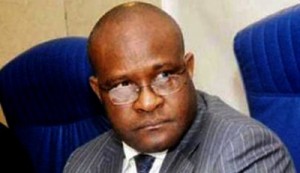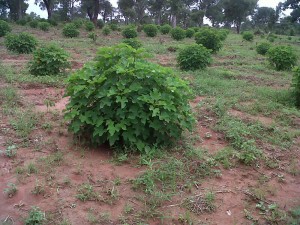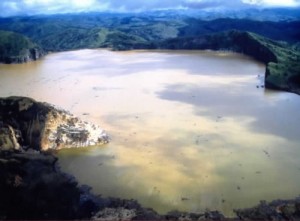Former Environment Minister, John Odey, has revealed that his passion towards ensuring the speedy execution of the N4.2 billion Kashimbilla/Gamovo Multipurpose Buffer Dam project in Taraba State while in office earned him a nickname among his peers in the Federal Executive Council (FEC).

Odey, who served as Environment Minister between December 2008 and May 2011, said that he was labelled “Mr. Lake Nyos” because he consistently brought up the issue during the weekly FEC meetings in Abuja.
The proposed dam is actually meant to serve as a buffer upon the event of an earthquake and the collapse of the lake’s wall, freeing its large volume of water, which is expected to flow along a course from its native Cameroun into neighbouring Nigeria, where settlements will be extensively flooded.
Odey, who is still very passionate over the environment and sustainable development, wants the authorities to expedite action on the actualisation of the dam, which is under construction. It can generate 40mw of electricity with the capacity for expansion to 60mw.
“The dam will provide portable water to Taraba State and irrigation for Taraba farmers and more areas in Benue State. I studied the dam and pushed for the acceleration of the project by Council. This earned me the name Lake Nyos in the FEC when I was Environment Minister.
“I can confirm President Goodluck Jonathan’s support to have this project completed. He sent us to inspect progress of work in May 2011,” he said.
On the perceived limited budget allocation in 2013 Budget foe Agriculture and Rural Development in the light of the recent nationwide flooding, Odey remarked: “It is important for the key players who understand the effect of policy to advise Mr. President on policies that will drive private sector investment. Budget as an instrument is not enough to set the goals for the sector. Favourable policies will do more.
“The value chain and post harvest processing is not in place. This is even more important that the vote for agriculture. The flooding will affect rice yield a lot. Our farmers depend on rain-fed agriculture and swarm rice a lot. We should begin to develop small irrigation projects powered by solar pump. This will yield a lot of result. We are working under Access Nigeria for LPG (liquefied petroleum gas) utilisation for cooking across the country to reduce dependence on firewood and kerosene. This will be useful for drying agric produce to ensure post harvest storage.
“Government intervention now is short term measure. Government must plan on a medium and long term measures. The budget itself is a short term instrument, considering the way we formulate and implement our budget. It is not drawn from a long term development plan at all.”
On the switch to LPG, he noted that Africa Access Initiatives is partnering with stakeholders on the project and considering the environment and eco-friendly cooking approach.
“We had met with Oando Plc on all the key issues including safety network and affordability issues to reach the grassroot. I met with Abba Ruma and others such as Chairman, NLC; chairman, Micro Banks Association; and president, Farmers Association.”
While expressing joy that the REDD+ initiative that he began while in office “has come to a fruitful beginning,” Odey stressed that he is operating a Jathropha farm in Okpoma in Cross River State, which will enable the production of bio-diesel from 2013.

Lake Nyos, a volcanic lake situated on the Cameroun border with Nigeria, covers an area of 1.48km2 and approximately 250m deep. It holds about 200,000 tonnes of water. Eruption of poisonous gases have occurred at Lake Nyos in 1954, 1982 and 1986, causing flooding and killing thousands of people.
The worst scenario feared with respect to the lake is the eventual failure of the 50m long wall of the lake, due to erosion of its lower unit. This would discharge an estimated 17,000m three- fifth of flood that would have tragic impact on the downstream areas as far as Nigeria, surging down the Rivers Katsina Ala and Benue. This will affect thousands of people in Adamawa, Taraba, Benue and Cross River states.
In 2001, the Camerounian Government initiated the degassing project supported by an International Advisory Committee and various funding agencies. This project involves principally the use of large polyethylene pipe to siphon CO2 continuously from the lower layers of the lake to its surface. In addition, CO2 early warning systems were set up around the lake to monitor the CO2 concentration in the atmosphere and trigger alert when concentration is dangerously high.

On the 5th of September, 2001, the FEC considered a joint memorandum by the Ministers of Science and Technology, Health and Environment on Eruption of dangerous gases from Mount Cameroon and directed that an Inter-Ministerial committee comprising Ministers of Science and Technology, Health, Environment, Water Resources and Special Duties be set up to study the problem of the dangerous gases emitted by Mount Cameroon and make recommendations to the Council.
Based on conclusions from the research works by academics especially those from Cameroun in 2005 that predicted the imminent collapse of the two lakes in a near future, the House of Representatives, Benue and Taraba States Governments noted the enormous catastrophe that may take place. In response to these, the National Technical Committee on Earthquake Phenomene (NTCEP) of which the Ministry is a member met to draw up a plan of attention for embarking on the necessary investigation of the problem.
Among the recommendations of the NTCEP were channelization of River Katsina Ala, installation of flood early warning system along the River and construction of buffer dam at Kashimbilla after proper Environmental Impact Assessment (EIA) is carried out. However, the installation of early warning system has been done and the dam project was awarded and is under construction now with several complaints from adjoining communities of increased flooding of their environment.
President Jonathan has taken commendable action by releasing funds for steady works on the construction of the Dam. The project which witnessed a slow progress before 2011 received strong support by this administration as remarked by John Odey. The dredging of River Niger also is a mitigation action that officials say must be commended and all efforts to complete the work should be vigorously pursued.
